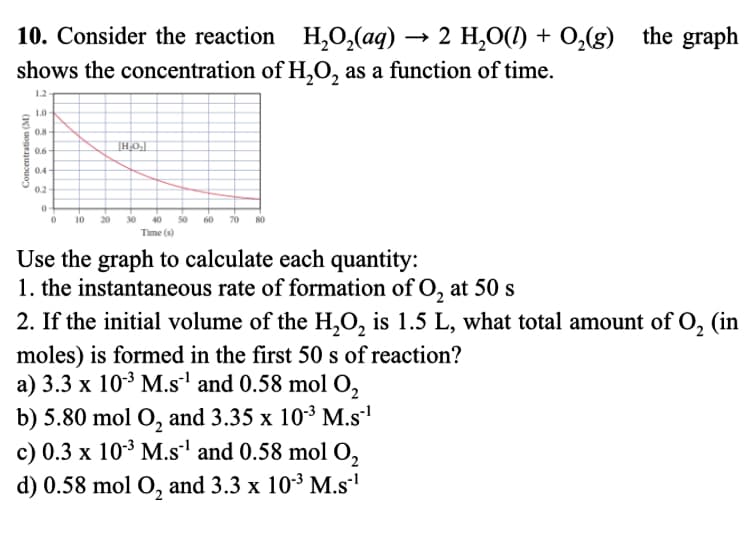10. Consider the reaction H₂O₂(aq) - . - shows the concentration of H₂O₂ as a function of time. 1.2- 1.0 0.8- 0.6- Concentration (M) 04- 0.2 0 0 2 H₂O(l) + O₂(g) the graph THON Time(s) Use the graph to calculate each quantity: 1. the instantaneous rate of formation of O₂ at 50 s 2. If the initial volume of the H₂O₂ is 1.5 L, what total amount of O₂ (in moles) is formed in the first 50 s of reaction? a) 3.3 x 10-³ M.s¹ and 0.58 mol O₂ b) 5.80 mol O₂ and 3.35 x 10-³ M.s¹ c) 0.3 x 10-³ M.s¹¹ and 0.58 mol O₂ d) 0.58 mol O₂ and 3.3 x 10-³ M.s¹
10. Consider the reaction H₂O₂(aq) - . - shows the concentration of H₂O₂ as a function of time. 1.2- 1.0 0.8- 0.6- Concentration (M) 04- 0.2 0 0 2 H₂O(l) + O₂(g) the graph THON Time(s) Use the graph to calculate each quantity: 1. the instantaneous rate of formation of O₂ at 50 s 2. If the initial volume of the H₂O₂ is 1.5 L, what total amount of O₂ (in moles) is formed in the first 50 s of reaction? a) 3.3 x 10-³ M.s¹ and 0.58 mol O₂ b) 5.80 mol O₂ and 3.35 x 10-³ M.s¹ c) 0.3 x 10-³ M.s¹¹ and 0.58 mol O₂ d) 0.58 mol O₂ and 3.3 x 10-³ M.s¹
Chemistry & Chemical Reactivity
9th Edition
ISBN:9781133949640
Author:John C. Kotz, Paul M. Treichel, John Townsend, David Treichel
Publisher:John C. Kotz, Paul M. Treichel, John Townsend, David Treichel
Chapter14: Chemical Kinetics: The Rates Of Chemical Reactions
Section: Chapter Questions
Problem 5PS: Experimental data are listed here for the reaction A 2 B. (a) Prepare a graph from these data;...
Related questions
Question
Please provide expl

Transcribed Image Text:10. Consider the reaction H₂O₂(aq) → 2 H₂O(l) + O₂(g) the graph
shows the concentration of H₂O₂ as a function of time.
1.2
Concentration (M)
1.0-
0.8-
0.6
0.4-
0.2-
0
0
H₂O₂
10 20 30 40 50
Time (s)
60
70 80
Use the graph to calculate each quantity:
1. the instantaneous rate of formation of O₂ at 50 s
2. If the initial volume of the H₂O₂ is 1.5 L, what total amount of O₂ (in
moles) is formed in the first 50 s of reaction?
a) 3.3 x 10³ M.s¹ and 0.58 mol O₂
b) 5.80 mol O₂ and 3.35 x 10-³ M.s-¹
c) 0.3 x 10-³ M.s¹ and 0.58 mol O₂
d) 0.58 mol O₂ and 3.3 x 10-³ M.s¹
Expert Solution
This question has been solved!
Explore an expertly crafted, step-by-step solution for a thorough understanding of key concepts.
This is a popular solution!
Trending now
This is a popular solution!
Step by step
Solved in 3 steps with 1 images

Knowledge Booster
Learn more about
Need a deep-dive on the concept behind this application? Look no further. Learn more about this topic, chemistry and related others by exploring similar questions and additional content below.Recommended textbooks for you

Chemistry & Chemical Reactivity
Chemistry
ISBN:
9781133949640
Author:
John C. Kotz, Paul M. Treichel, John Townsend, David Treichel
Publisher:
Cengage Learning

Chemistry for Engineering Students
Chemistry
ISBN:
9781337398909
Author:
Lawrence S. Brown, Tom Holme
Publisher:
Cengage Learning

Chemistry & Chemical Reactivity
Chemistry
ISBN:
9781337399074
Author:
John C. Kotz, Paul M. Treichel, John Townsend, David Treichel
Publisher:
Cengage Learning

Chemistry & Chemical Reactivity
Chemistry
ISBN:
9781133949640
Author:
John C. Kotz, Paul M. Treichel, John Townsend, David Treichel
Publisher:
Cengage Learning

Chemistry for Engineering Students
Chemistry
ISBN:
9781337398909
Author:
Lawrence S. Brown, Tom Holme
Publisher:
Cengage Learning

Chemistry & Chemical Reactivity
Chemistry
ISBN:
9781337399074
Author:
John C. Kotz, Paul M. Treichel, John Townsend, David Treichel
Publisher:
Cengage Learning

Chemistry: Principles and Reactions
Chemistry
ISBN:
9781305079373
Author:
William L. Masterton, Cecile N. Hurley
Publisher:
Cengage Learning


Chemistry
Chemistry
ISBN:
9781305957404
Author:
Steven S. Zumdahl, Susan A. Zumdahl, Donald J. DeCoste
Publisher:
Cengage Learning